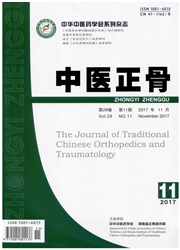

 中文摘要:
中文摘要:
目的:研究骶髂关节紊乱与L4~5椎间盘突出的关系。方法:将129例腰椎间盘突出症患者分为2组,L4~5椎间盘突出的61例患者纳入观察组,L5S1椎间盘突出的68例患者纳入对照组。采用病例对照研究的方法计算骶髂关节紊乱对L4~5椎间盘突出症发病的危险度。采用流行病学调查的方法确定L4~5椎间盘突出的有关因素,然后采用单因素分析对自变量进行筛选,最后通过Logistic回归分析确定L4~5椎间盘突出的危险因素。结果:病例对照研究的结果表明骶髂关节紊乱是L4~5椎间盘突出的危险因素(OR=2.310,P=0.030)。流行病学调查共确定了17个与L4~5椎间盘突出有关的因素,经单因素筛选确定对年龄、"4"字形试验、腰痛、腰部压痛、腰椎侧弯、髂嵴不平及腰骶角异常7个变量进行Logistic回归分析,结果显示腰痛(OR=3.924,P=0.088)、腰椎侧弯(OR=3.308,P=0.072)、髂嵴不平(OR=21.376,P=0.002)及腰骶角异常(OR=2.212,P=0.057)为L4~5椎间盘突出的危险因素,其中髂嵴不平为高危险因素。结论:骶髂关节紊乱是L4~5椎间盘突出的危险因素,其中髂嵴不平是L4~5椎间盘突出的高危因素。
 英文摘要:
英文摘要:
Objective:To study on the relationship between sacroiliac joint dysfunction and L4/5 lumbar disc herniation(LDH).Methods:One hundred and twenty-nine LDH patients were divided into 2 groups,61 patients with L4/5 LDH were included into observation group,while the others with L5S1 LDH were included into control group.The risk for L4/5 LDH caused by sacroiliac joint dysfunction was assessed through case-control study.The relative factors of L4/5 LDH were determined through epidemiologic investigation,then the independent variables were screened through single factor analysis,and the risk factors for L4/5 LDH were determined through logistic regression analysis finally.Results:It was proved that sacroiliac joint dysfunction was the risk factor for L4/5 LDH according to the findings of case-control study(OR=2.310,P=0.030).Seventeen factors were determined to have relation with L4/5 LDH through the epidemiologic investigation.After single factor screening,7 independent variables,including age,Patrick sign,lumbago,waist tenderness,lumbar scoliosis,uneven iliac crest and abnormal lumbosacral angle,were analyzed through logistic regression analysis.The results showed that such factors were the risk factors for L4/5 LDH as lumbago(OR=3.924,P=0.088),lumbar scoliosis(OR=3.308,P=0.072),uneven iliac crest(OR=21.376,P=0.002)and abnormal lumbosacral angle(OR=2.212,P=0.057),and the uneven iliac crest was the high risk factor.Conclusion:The sacroiliac joint dysfunction is the risk factor for L4/5 LDH,and the uneven iliac crest is the high risk factor.
 同期刊论文项目
同期刊论文项目
 同项目期刊论文
同项目期刊论文
 期刊信息
期刊信息
